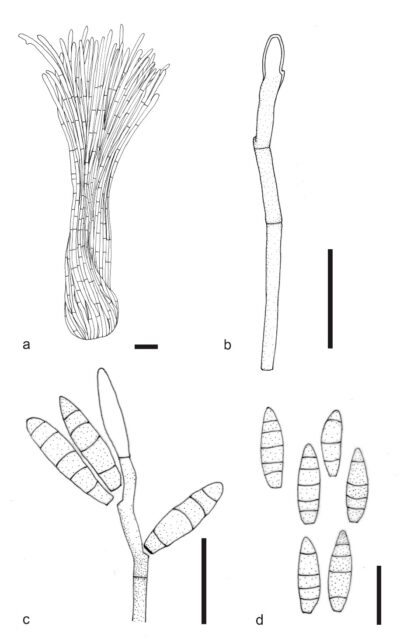Fungalpedia – Note 307, Sympodiosynnema
Sympodiosynnema J.W. Xia & X.G. Zhang
Citation when using this entry: Perera et al. 2024 (in prep) – Fungalpedia, genera described in 2016.
Index Fungorum, Facesoffungi, MycoBank, GenBank, Fig. 1
Classification: Incertae sedis, Incertae sedis, Incertae sedis, Incertae sedis, Pezizomycotina, Ascomycota, Fungi
Xia et al. (2016) introduced this monotypic genus Sympodiosynnema to accommodate Sympodiosynnema elegans based on the morphology. Sympodiosynnema elegans was isolated from a dead plant stem in China. The asexual morph is characterized by effuse, brown colonies on the natural substrate. Mycelium is mostly immersed, and comprised of branched, septate, hyaline to brown, smooth-walled hyphae. Synnematal conidiomata are unbranched, erect, with brown stalks, and consist of a compact cluster of parallel conidiophores. Conidiophores are macronematous, pale brown to brown, erect, unbranched, septate, divergent towards the distal part of the synnema. Conidiogenous cells are polyblastic, integrated, terminal, sympodial and hyaline to pale brown. Conidia are solitary, dry, naviculiform, euseptate, pale brown, and exhibit schizolytic secession (Xia et al. 2016). The sexual morph remains undetermined. Sympodiosynnema elegans is most closely related to Sympodioplanus capensis in conidial shape, but differs by its smaller conidia (Xia et al. 2016).
Type species: Sympodiosynnema elegans J.W. Xia & X.G. Zhang
Other accepted species: This genus is monotypic.
Figure 1 – Sympodiosynnema elegans (HSAUP H6447, holotype). a Synnema. b conidiogenous cells and conidiogenous loci. c Conidiogenous cells and conidia. d Conidia. Scale bars: a–d = 20 μm. Redrawn from Xia et al. (2016)
Reference
Entry by
Rekhani Hansika Perera, Center of Excellence in Fungal Research, Mae Fah Luang University, Chiang Rai, 57100, Thailand.
(Edited by Kevin D. Hyde, Samaneh Chaharmiri-Dokhaharani, & Achala R. Rathnayaka)
Published online 8 July 2024
